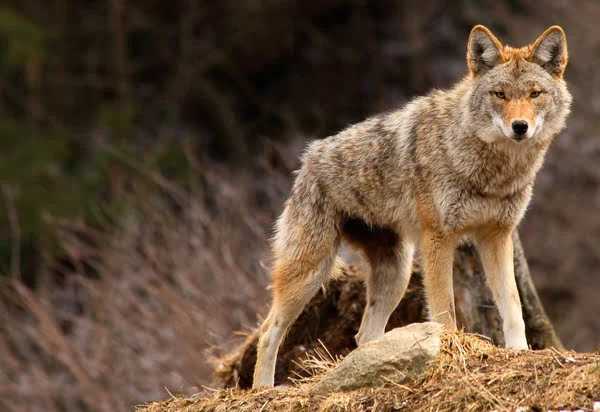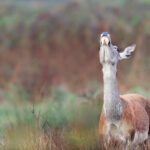Coyotes are resilient predators, often outsmarting hunters, ranchers, and even wildlife biologists.
Game cameras and home security cameras are often used to track coyotes and human conflict…but can coyotes see infrared light used on these devices?
Table of Contents
- Can Coyotes See Infrared Light?
- The Big Picture
- Coyote Eyesight & Behavior
- What Is Infrared Light?
- Related Posts
Can Coyotes See Infrared Light?
Very little research has been done to specifically investigate the vision range of coyotes (Canis latrans) but there is some evidence that suggests they may react to flashes of wildlife cameras that are advertised as infrared.

This is really referring to the coyotes being able to see a lower wavelength of light than what humans can normally detect.
When observed in behavioral studies, many predatory animals in the weasel, cat and wild dog families were observed reacting to infrared camera flashes in different ways which suggests that they could see the lights.
However, the sound produced by wildlife cameras when triggered could also be a factor in these reactions.
Recent research done with domestic dogs has revealed an ability to sense differences in thermal radiation using their noses.
The study identified this new sense using both behavioral observations and brain scans, which identified which part of the brain was used to process this sensory information.
The study revealed that dogs (a close relative of the coyote) can determine differences in thermal radiation at short range, like snakes. This infrared sense in dogs is thought to have originally evolved in ancestors of domestic dogs to help them identify warm bodies while hunting.
Both domestic dogs and coyotes belong to the Canidae family, which also includes wolves, foxes, and jackals. Dogs, coyotes, and wolves all share a recent common ancestor within the family, but dogs and wolves began to differentiate from coyotes about 3 to 4 million years ago.
However, based on their close evolutionary and genetic history, it is reasonable to assume that coyotes share many adaptations with dogs and wolves.
Therefore, it is highly possible that coyotes share the domestic dog’s ability to detect infrared heat using their nose.
The Big Picture
Whether you are interested in capturing nighttime photos of coyotes, eliminating predatory threats to your pets and livestock, or just learning more about a common wild animal, it is useful to know whether coyotes can see infrared light.
If coyotes can detect infrared light on cameras and other equipment, it could affect their behavior around this technology.
There is some evidence that suggests coyotes are able to detect lower wavelengths of light than what is detectable to the human eye.
Seeing these lights emitted by wildlife cameras causes them to be startled or to avoid areas with these cameras. New research also shows that domestic dogs, close relatives of coyotes, can sense thermal radiation differences using their noses.
This is similar to the way snakes “see” infrared and can be interpreted as evidence that dogs also see infrared.
Based on the evidence, there is a high likelihood that coyotes can see lower wavelengths of light than humans, as well as sense infrared radiation with their noses. So overall, yes coyotes can see infrared!
Coyote Eyesight & Behavior
Coyotes are often portrayed as cunning, tricky, and clever in folklore and popular culture.
Their adaptability has made them a widespread species, capable of thriving anywhere from downtown parks to remote desert landscapes.
Attitudes towards coyotes vary greatly, with some people wanting to photograph them as natural wildlife, and others considering them dangerous pests or trophies to hunt.
Understanding if coyotes can see infrared light is important for getting to know these successful survivalists in any context.
Due to their ability to survive in almost any environment, coyotes are often involved in human-wildlife conflicts.

Coyotes are predators that can and will attack pets, as well as small livestock like calves, lambs, or ewes. Attacks on people are rare but possible.
To protect yourself, your pets, and your livestock, you may want to deter coyotes from your property or eliminate the threat entirely by trapping or hunting problem animals.
Wildlife cameras are a popular way to monitor coyote activity in an area for sport or wildlife photography. These cameras can capture photos and videos of any animals that wander by day or night.
When cameras are taking pictures or record video in low light, they typically use red-colored light or infrared light to illuminate the animal in the frame. This is an essential feature for capturing images of coyotes, which are most active at dawn, dusk, and nighttime.
To use these cameras properly to track coyotes, it is important to know how the light they emit might affect the animals.
What Is Infrared Light?
Energy exists in the form of waves with different wavelengths. The wavelengths that are visible to the human eye produce the colors of the rainbow that we can see.
Other wavelengths produce light that is not detectable by the human eye, such as ultraviolet or infrared light. Some animals can detect wavelengths outside the visible spectrum of humans.
This helps them to identify food, predators, and mates. For example, many insects can see ultraviolet patterns on flowers that look solid colored to the human eye.
The ability to “see” infrared light is usually referring to an ability to sense thermal radiation from objects.
Opposed to using photoreceptors that detect light, animals which can see in infrared detect heat with thermal receptor structures in their eyes, or other parts of their bodies.
Snakes are one of the most studied, and most well-known, examples of this kind of vision in the animal kingdom. Other known examples include mosquitos and vampire bats.





